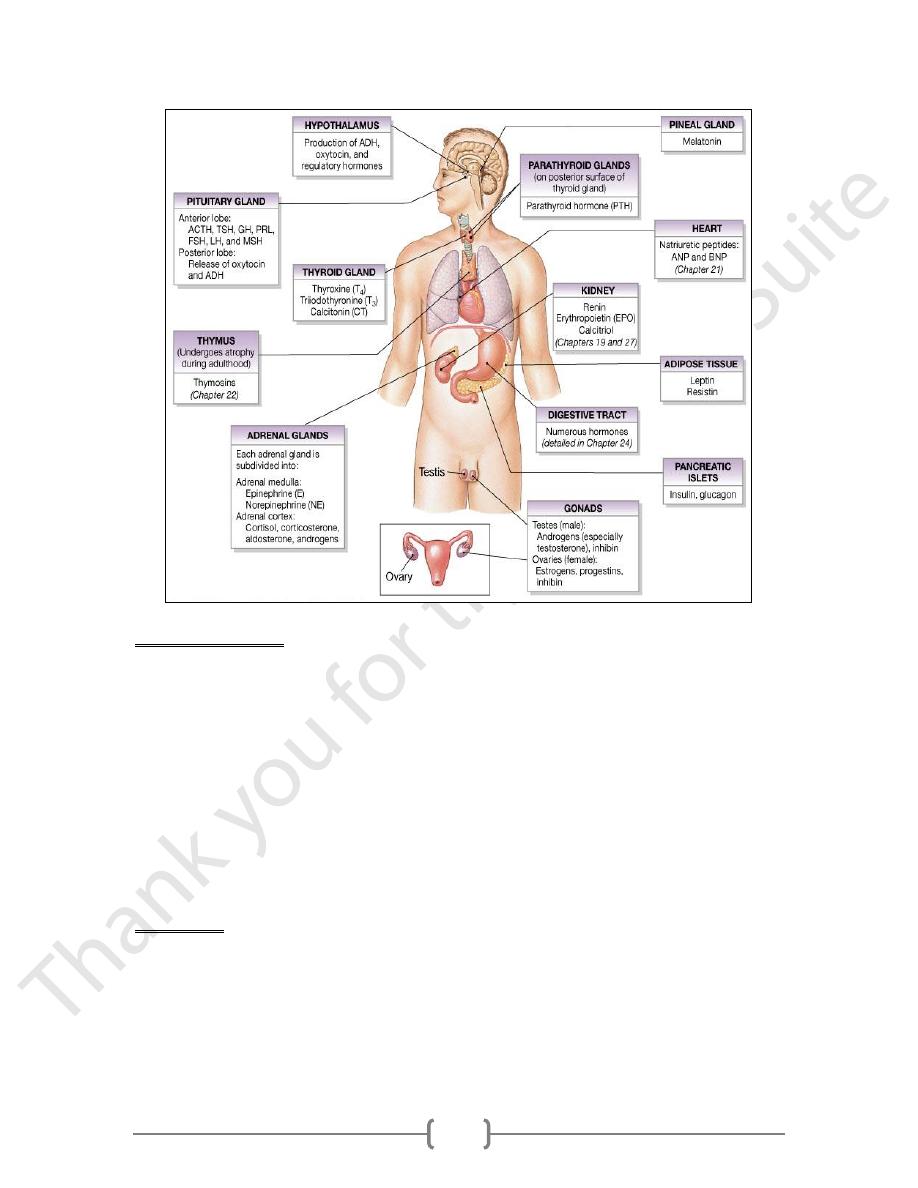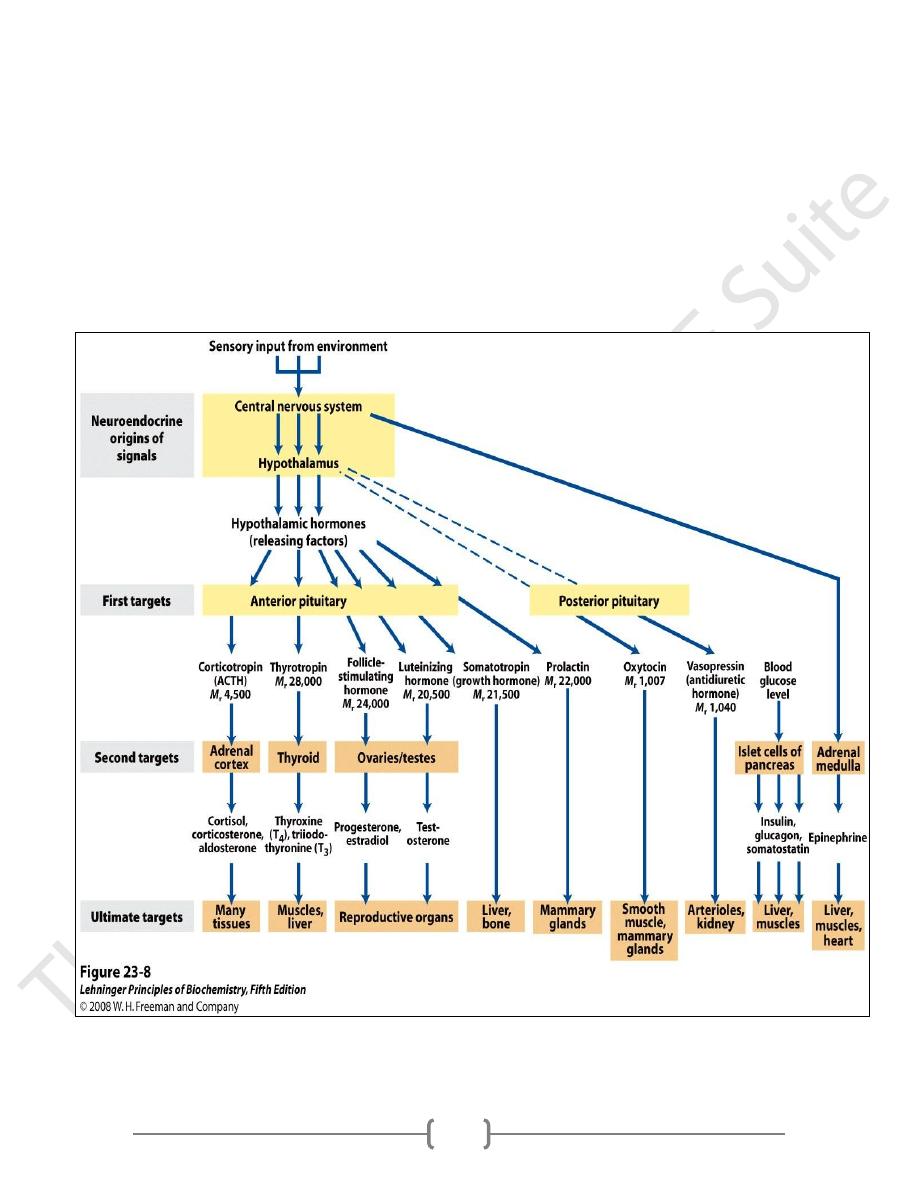
2
Lec1. Hormones
Objective of this lecture:
To know what are hormones, their functions in the body.
To recognize the chemical classes of hormones.
Regulation of hormones and the concept of feedback systems
Communication among various regions of the body is essential for enabling the organism
to respond appropriately to any changes in the internal and external environments. Two
systems help ensure communication: the nervous system and the hormonal (endocrine)
system. The nervous system generally allows rapid transmission (i.e., within fractions of
seconds) of information between different body regions. Conversely, hormonal
communication, which relies on the production and release of hormones from various
glands and on the transport of those hormones via the bloodstream, is better suited for
situations that require more widespread and longer lasting regulatory actions. Thus, the
two communication systems complement each other. In addition, both systems interact:
Stimuli from the nervous system can influence the release of certain hormones and vice
versa.
The endocrine system comprises a group of glands that secrete hormones directly into the
bloodstream, together with the receptors for these hormones and the intracellular
signaling pathways they invoke.
hormones control the growth, development, and metabolism of the body; the
electrolyte composition of bodily fluids; and reproduction
The endocrine system composed of:
•
Endocrine glands
•
Hormones
•
Receptors
•
Target tissues
Hormone is a substance secreted by an endocrine gland, then transported in the blood to
regulate the function of other tissue. Some hormone as thyroxine, insulin and growth
hormone influence tissue metabolism directly ,while other hormones stimulate target
endocrine gland to synthesize and secret other hormones…some hormones can act on
adjacent cells (paracrine action) and on the cell in which they were synthesized (autocrine
action) without entering the systemic circulation

3
Hormone receptors are Molecules within or on the surface of target cells that bind
hormones with high affinity and specificity. All receptors have at least two functional
domains:
1. recognition domain binds the hormone (sometime the hormone is called ligand) and
2.Coupling domain - generates signal that couples hormone recognition to some
intracellular function.
According to the location of the receptors, they could be:
A. Cell surface receptors
B. Intracellular receptors
1) Nuclear receptors
2) Cytoplasmic receptors
Target cells : Hormones will only produce the response in cells that express the receptors
for this particular hormone these cells are called (target cells) ONLY target cells respond
to hormone. While the cells that do not have receptors for the hormone “ignore” the
hormone.
Hormones in the circulation can be freely circulating or Bound to transport proteins e.g.
albumin or globulin

4
Functions of the endocrine system
1.Maintain Internal Homeostasis(i.e stable internal environment) by controlling:
A. Metabolism (metabolism is all chemical reactions that occur in living
organisms, including digestion and the transport of substances into and between different
cells, These processes allow organisms to grow and reproduce, maintain their structures,
and respond to their environments)
B. Osmoregulation
2. Regulate Growth and Morphological change.
3. Coordinate Development
4. Coordinate Reproduction
5. Facilitate Behavioral and Social interactions
Chemical Classification of hormones
1. Amine hormones are derived from the amino acid tyrosine Include the catecholamine
(epinephrine, norepinephrine) which are water soluble and ,and thyroid hormones which
are lipid soluble
2. Polypeptide/protein hormones are chains of amino acids
As the Growth hormone(GH), insulin, oxytocin, glucagon, ACTH, Parathyroid
hormone(PTH) these hormones are water soluble,
some hormone are glycoproteins (Long
polypeptide bound to a carbohydrate group as Luetinizing (LH), Follicle stimulating (FSH),
Thyroid stimulating H(TSH)
.
3. Steroids hormones derived from cholesterol , example testosterone, estrogen,
progesterone & cortisol
Tyrosine
derivatives
Steroids
Proteins
• Epinephrine
• Norepinephrine
• Dopamine
Thyroid hormone
• Testosterone
• Estradiol
• Progesterone
• Adrenal
cortex
hormones
• Estrogen
Insulin Glucagon
Oxytocin Vasopressin
Adrenocorticotropic hormone
Thyroid-stimulating hormone
Thyrotropin-releasing hormone
Somatostatin Follicle-stimulating hormone
Luteinizing hormone
Gonadotropin-releasing hormone
Growth hormone
Prolactin
Corticotropin-releasing hormone
Growth hormone-releasing hormone
Parathyroid hormone
Calcitonin
Chorionic gonadotropin

5
Regulation of hormone secretion
1) Feedback control
a. Negative
b. Positive
Feedback loops are used extensively to regulate secretion of hormones especially in the
hypothalamic-pituitary axis. An important example of a negative feedback loop is seen in
control of thyroid hormone secretion
Negative Feedback means that the increases in one hormone leads to the decrease in the
secretion of other hormone (it is a common regulatory mechanism in the endocrine
system) example
thyroid hormone inhibits secretion of TRH and TSH
Positive feedback;means that the increase in one hormone leads to increase the secretion
of another hormone
2) Neural control(as visual, olfactory)
Neural input to hypothalamus stimulates synthesis and secretion of hypothalamic
releasing factors which stimulate pituitary hormone production and release
3) Chronotropic Control (Endogenous rhythmicity ) as Diurnal rhythms, circadian
rhythms for growth hormone and cortisol), Sleep-wake cycle; seasonal rhythm,
Hormones transport
The class I hormones (lipid soluble hormone) are hydrophobic and thus are not very
soluble in plasma. These hormones, (the steroids and thyroid hormones), have specialized
plasma transport proteins that serve several purposes First, these proteins circumvent the
solubility problem and thereby deliver the hormone to the target cell. They also provide a
circulating reservoir of the hormone, Hormones, when bound to the transport proteins,
cannot be metabolized, thereby prolonging their plasma half-life). The binding affinity of
a given hormone to its transporter determines the bound versus free ratio of the hormone.
This is important because only the free form of a hormone is biologically active. In
general, the concentration of free hormone in plasma is very low, The water soluble
hormones—are freely soluble in plasma and do not require transport proteins as insulin,
growth hormone, ACTH, and TSH circulate in the free, active form and have very short
plasma half-lives.
Hormone degradation
Degradation of hormones and their subsequent excretion are processes that are just as
important as secretion. Inactivation of hormones occurs enzymatically in blood or
intercellular spaces, in liver or kidney cells, as well as in the target cells.
Degradation of peptide and protein hormones often involves uptake into cells by a
mechanism of endocytosis that delivers them to the cellular sites of degradation(the

6
lysosomes and proteasomes). Inactivation may involve complete metabolism of the
hormone so that no recognizable product appears in urine, or it may be limited to some
simple one- or two-step process such as additionof a methyl group or glucuronic acid. In
the latter cases recognizable degradation products are found in urine so the Fates of
Hormone Metabolism may be:
o
A. Target cell uptake
o
B. Metabolic degradation ;Urinary or biliary excretion (kidney and liver are the major
sites of hormone metabolism and degradation)
